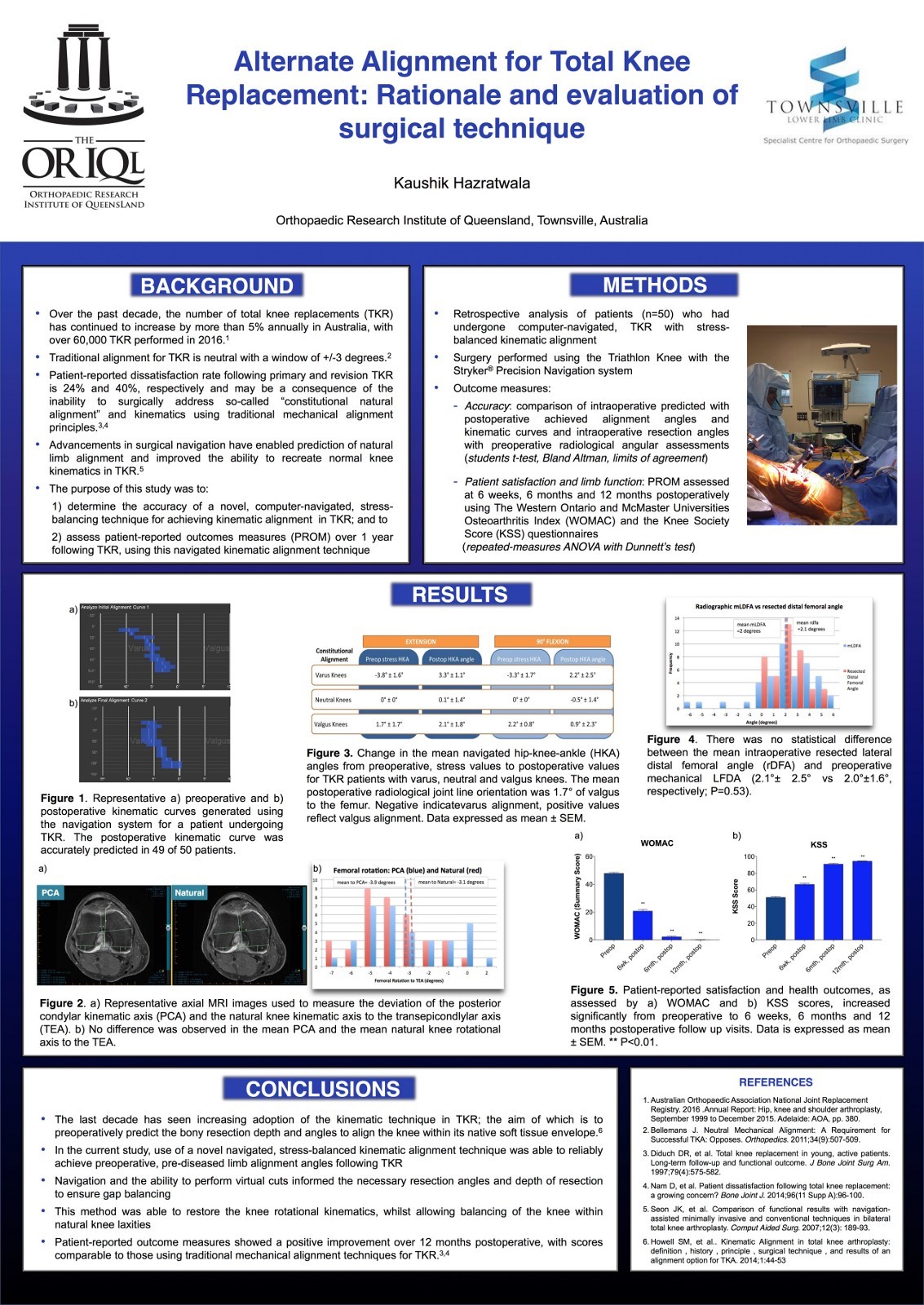Alternate Alignment Technique for Total Knee Replacement
Alternate alignment is gaining popularity amongst orthopaedic surgeons. The alternate alignment principal for total knee is based on the gap balancing principal, allowing the medial and lateral soft tissue envelope to remain at their native lengths.12
It is an anatomical tibia 1st technique with subsequent femoral cuts to balance the knee within its native soft tissue envelope, Compared to mechanical alignment, use of the alternate alignment technique results in the femoral component being slightly valgus and the tibial component slightly varus, in most cases without affecting mean HKA alignment and leading to improved early functional outcomes.13
Cadaveric studies have shown alternate alignment in TKA reduces tibial forces and contact, although these studies were only performed on native rather than osteoarthritis knees.14
Howell et al.15 followed a cohort of kinematically aligned postoperative neutral and varus/valgus outliers and found no incidence of failures for any category after 31 months, with comparable functional scores for the three alignment categories.
The utility of specific postoperative target alignment categories for TKA patients was recently questioned by Rames et al.16, who found no significant benefit to functional outcomes regardless of whether patients were corrected to neutral, mild varus, severe varus or valgus mMPTA postoperatively. The authors highlight the contribution of factors other than coronal alignment toward implant survivorship, including ligament balancing and component rotation.
Unlike mechanical alignment, alternate alignment does not target a specific postoperative alignment category, instead restoring the joint line to its native alignment.
However, there is concern that, particularly for patients with severe preoperative varus or valgus alignment, this technique may increase the risk of catastrophic failure of the implants.2,9 Stan et al.17 demonstrated using finite element analysis, that knee balancing significantly reduces the contact pressure on the tibial polyethylene insert and improves prosthesis survival. The authors however caution that increasing tibial varus tilt beyond 3° may have a detrimental effect on pressure distribution across the tibial component. Further studies are therefore warranted to determine the suitability of alternative alignment for patients with constitutional varus or valgus deformity and to better understand the effect this has on risk of catastrophic failure of the tibial component.
I’m sharing intra operative Navigated resection and alignment parameters of my first 50 Alternate Aligned Knees. It shows that the Alternate alignment resection is very similar to the preoperatively templated Resection angles.

REFERENCES
- Green GV, Berend KR, Berend ME, Glisson R, Vail TP. The effects of varus tibial alignment on proximal tibial surface strain in total knee arthroplasty: The posteromedial hot spot. J Arthroplast 2002;17:1033-1039.
- Werner FW, Ayers DC, Maletsky LP, Rullkoetter PJ. The effect of valgus/varus malalignment on load distribution in total knee replacements. J Biomech 2005; 38:39-55.
- Bellemans J, Colyn W, Vandenneucker H, Victor J. The Chitranjan Ranawat Award: is neutral mechanical alignment normal for all patients? The concept of constitutional varus. Clin Orthop Relat Res. 2012;470(1):45-53. doi:10.1007/s11999-011-1936-5.
- Dunbar MJ, Richardson G, Robertsson O. I can’t get no satisfaction after my total knee replacement. Bone Joint J 2013;95-B(11 Supple A).
- Robertsson O, Dunbar M, Pehrsson T, Knutson K, Lidgren L. Patient satisfaction after knee arthroplasty: A report on 27,372 knees operated on between 1981 and 1995 in Sweden. Acta Orthop Scand. 2000;71(3):262-267. doi:10.1080/000164700317411852.
- Nam D, Nunley RM, Barrack RL. Patient dissatisfaction following total knee replacement: a growing concern? Bone Joint J 2014;96-B(11 Supple A):96-100. doi:10.1302/0301-620X.96B11.34152.
- Vandekerckhove PJ, Lanting B, Bellemans J, Victor J, MacDonald S. The current role of coronal plane alignment in Total Knee Arthroplasty in a preoperative varus aligned population: an evidence based review. Acta Orthops Belg. 2016;82:129-142.
- Bargren JH, Blaha JD, Freeman MA. Alignment in total knee arthroplasty: correlated biomechanical and clinical observations. Clin Orthop Relat Res 1983;173:178-183.
- Ritter MA, Davis KE, Davis P, et al. Preoperative malalignment increases risk of failure after total knee arthroplasty. J Bone Joint Surg Am 2013;95:126-131.
- Parratte S, Pagnano MW, Trousdale RT, Berry DJ. Effect of postoperative mechanical axis alignment on the fifteen-year survival of modern, cemented total knee replacements. J Bone Joint Surg Am 2010;92:2143-2149.
- Van Lommel L, Van Lommel J, Claes S, Bellemans J. Slight undercorrection following total knee arthroplasty results in superior clinical outcomes in varus knees. Knee Surg Sports Traumatol Arthrosc 2013;21:2325-2330.
- Howell SM, Papadopoulos S, Kuznik KT, Hull ML.Accurate alignment and high function after kinematically aligned TKA performed with generic instruments. Knee Surg Sports Traumatol Arthrosc 2013; 21:2271-2280.
- Dosset HG, Estrada NA, Swartz GJ, LeFevre GW, Kwasman BG. A randomised controlled trial of kinematical and mechanically aligned total knee replacements: two-year clinical results. Bone Joint J 2014;96-B:907-913.
- Roth JD, Howell SM, Hull ML. Kinematically aligned total knee arthroplasty limits high tibial forces, differences in tibial forces between compartments, and abnormal tibial contact kinematics during passive flexion. Knee Surg Sports Traumatol Arthrosc 2017; doi: 10.1007/s00167-017-4670-z
- Howell SM, Howel SJ, Kuznik KT, Cohen J, Hull ML. Does a kinematically aligned total knee arthroplasty restore function without failure regardless of alignment category? Clin Orthop Relat Res 2013;471:1000-7.